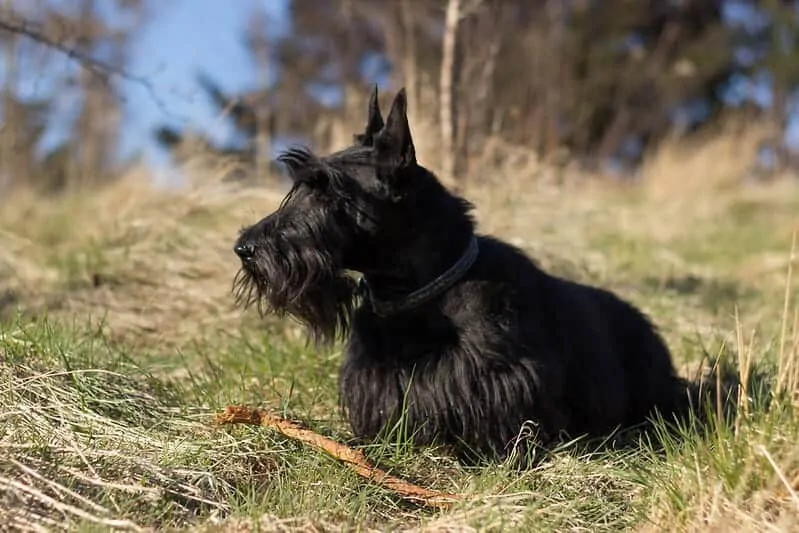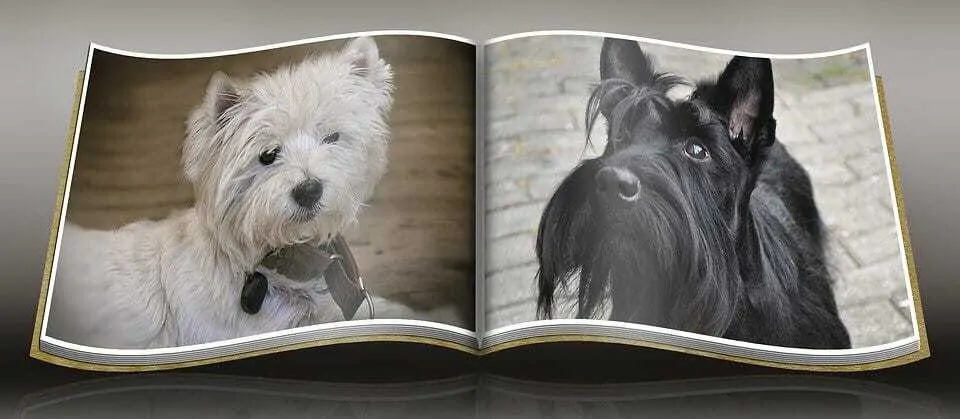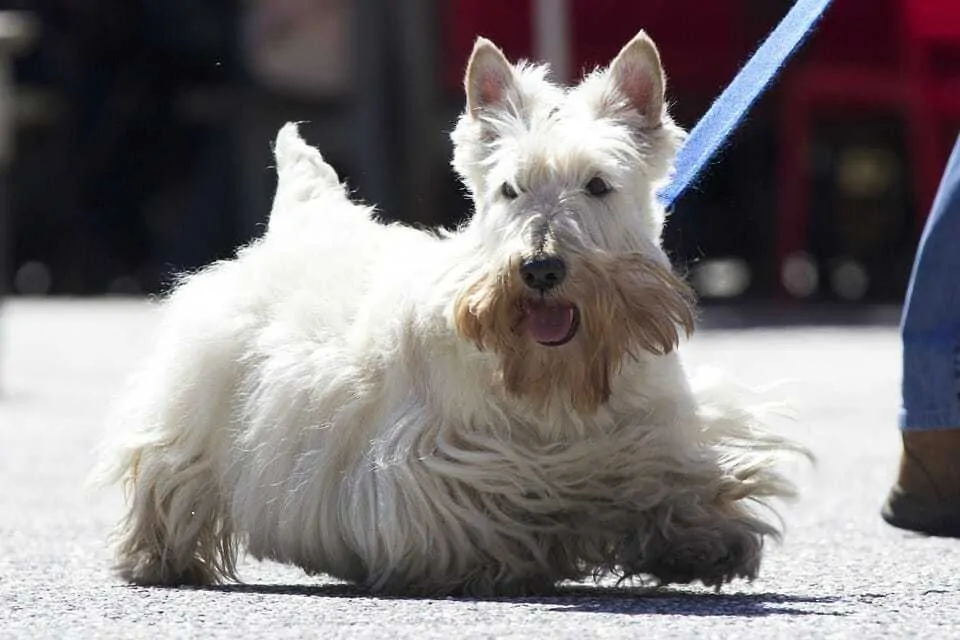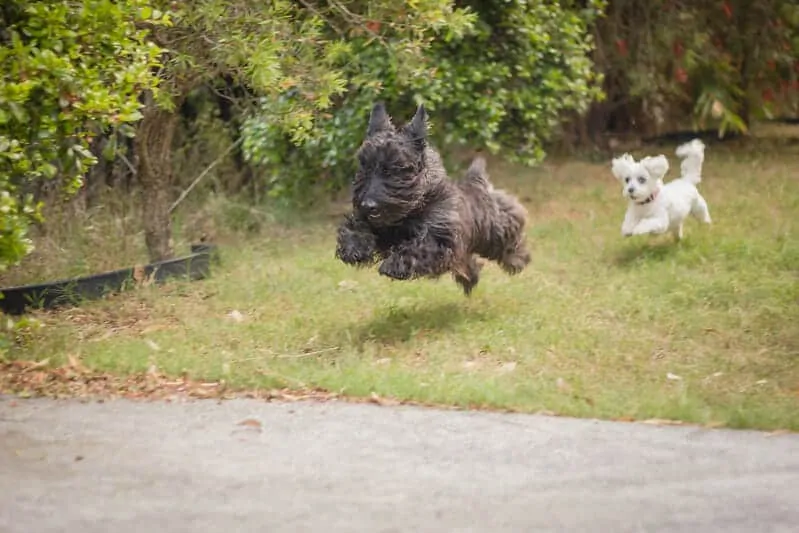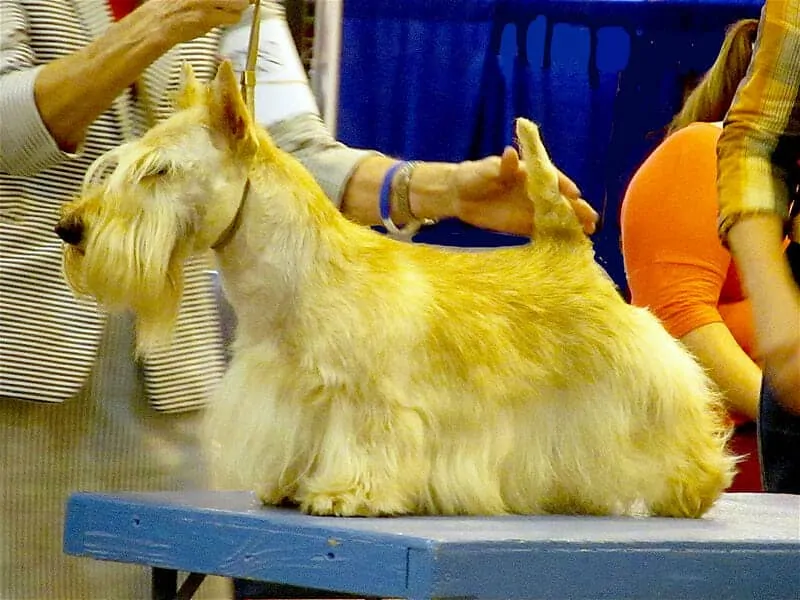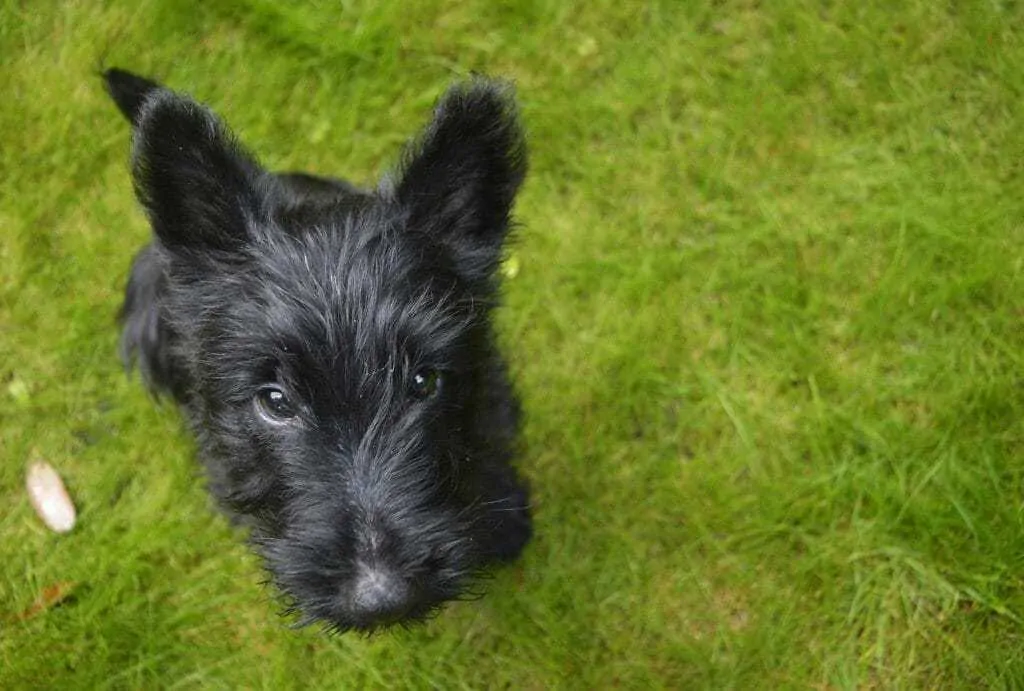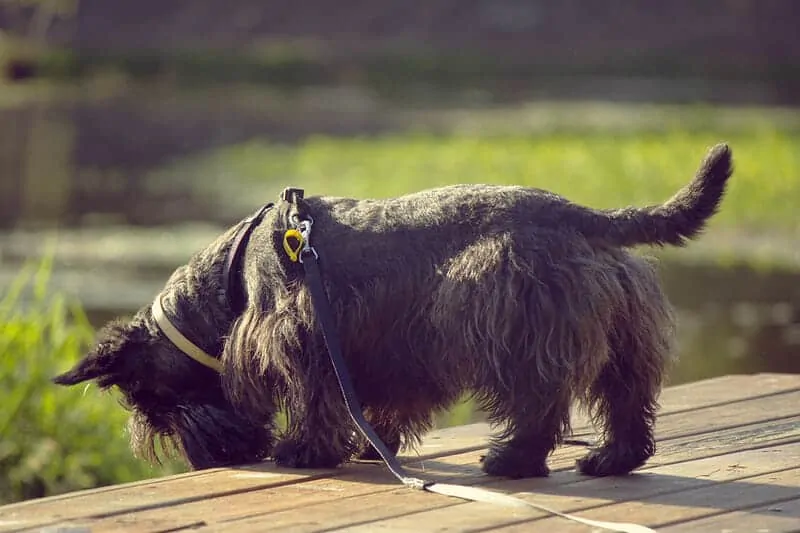Spunky, fearless, and packed full of personality, the Scottish terrier is one of the most well-known dog breeds in the world. And with the fun-loving personality and get-up-and-go of a large dog packed into a compact frame, that notoriety is well deserved. But that doesn’t mean the spicy Scottie is the right dog for everyone.
Keep reading to find out if the Scottish terrier would make a good addition to your household.
Contents
General Characteristics of the Scottish Terrier
- Other names: Aberdeen Terrier
- Height: 10 inches
- Weight: 18 to 22 pounds
- Lifespan: 12 years
- Origin: Scotland
- Colors: Black, wheaten, brindle
- Activity level: medium to high
- Grooming needs: Medium to high
- Best suited for: Active families or individuals with or without a lot of space
The aptly nicknamed “Scottish diehard” is a spirited dog with a lot of drive and a “varminty” expression. They can make wonderful pets assuming they have an owner experienced with high-drive terriers. “Asgard” by Dawid Kolano / CC BY-ND 2.0
The History of the Scottish Terrier
The exact origins of the Scottish Terrier as we know it today are hard to decipher.
There were a number of small terrier breeds popular in Scotland as far back as the 1400s. Despite differing colorations, builds, and uses, these terriers were all referred to as “Skye terriers.” What we do know is that the feisty dogs originating from the Blackmount and Moor regions of the country eventually gave rise to both the Scottie and West Highland.
How long the two were distinct breeds or if either one gave rise to the other, is much harder to discern.
In any case, the first terriers of Scotland were used to hunt varmint with the feistier, more sturdy Scottie-types being preferred to use against badgers, foxes, and other more substantial pests.
In the 17th century, King James I of England, who was originally King of Scotland, sent a small pack of terriers to the King of France as a gift. The dogs, which closely resembled today’s Scotties, quickly grew in popularity around Europe.
But it wasn’t until the end of the 19th century that there was a concerted effort to create purebred lines out of the many different terrier-types found in Scotland. The growing popularity of dog shows quickly expedited this process while also growing the popularity of the frequent breed champion, the now easily recognizable Scottish terrier.
Scotties and West Highlands may be closely related, but the dogs are easily distinguishable given the Scottish diehard’s elongated muzzle and oversized head and long, low body.
Scotties made their way to America around the turn of the century but would not become household names until after the first World War. In fact, by the mid-thirties, the breed was the third most popular in the country, that popularity largely spurred by Fala, the beloved pet of then president Franklin D. Rosevelt.
While Scottish Terriers don’t enjoy quite the same degree of popularity today, they are still one of the most easily recognizable breeds on the planet. And for devoted owners of this little “diehard,” there is no more perfect companion out there.
The Temperament of the Scottish Terrier
Like all terriers, the Scottie comes with equal parts moxie and devotion. They are an active breed that requires more than a long walk to tire them out. They want short bursts of excitement and enjoy playing high-drive games like tug, fetch, and chase more than just meandering around the block.
Their prey drive is very much intact and they will enjoy time in the yard so they can practice their skill against unwitting squirrels and birds. This same feistiness can make them difficult companions for other dogs and for families with small children. But with the right socialization and boundaries, they do make very loyal family pets.
The Scottish diehard’s high prey drive and active nature can make walking them without a leash a dangerous proposition. It is always best to have these dogs safely tethered to you unless you are in an enclosed space.
While these dogs can be noisy, they make surprisingly good pets for apartment living, provided they receive enough attention and plenty of playtime.
They can be stubborn and troublesome for both owners that give too much and too little. Their natural aloofness and fiery heart make them great watchdogs. While they may not always trust a stranger upon first meeting, they should warm up and make friends fast provided the person has their best interest in mind.
Overall, the Scottie is an independent and courageous dog who enjoys living life to the fullest all day and snuggling up on the couch with their favorite person in the evenings. They are mighty and energetic but come in a small package that can fit well into many lifestyles.
Health Issues Common to the Scottish Terrier Breed
While the breed is known for its diehard spirit and tenacity, it is plagued with a number of health problems that can get in the way of a full life. Here are a few of the more common issues you should be aware of.
- Cataracts
- Glaucoma
- Skin issues
- Craniomandibular osteopathy
- Scottie cramp
- Von Willebrand’s disease
- Cancer
Despite topping out at just around 22 pounds, Scotties have a life expectancy much closer to that of a medium to large breed dog. The many health issues that are seen in the breed have a lot to do with that.
Finding a reputable breeder is key to avoiding a Scottie who is likely to develop multiple health issues. Always screen your breeder, visit the breeding facility, and meet the parent dogs when possible.
Some diseases are entirely genetic and only occur when both parents are carriers of the condition.
Von Willebrand’s disease is a clotting disorder that can cause extended bleeding after trauma or frequent nose bleeds. Luckily, most Scotties have the least severe form of the condition which can easily be managed with certain protocols and medications as needed.
Scottie cramp is another of these recessive diseases most commonly seen in Scotties and other Scottish breeds. It is a neurological condition that affects a dog’s ability to make and use serotonin in times of high stress. Dogs suffering from the condition will show sudden stiffness in their legs and back, preventing them from being able to move. The dog remains awake during the episode and will regain full function once the cause of the stress is removed.
More serious than either of these hereditary diseases is the Scottie’s increased risk of multiple cancers. Multiple sarcomas and malignant melanoma are common but bladder cancer is by far the type that plagues the breed most frequently. In fact, according to the North England Scottish Terrier Club, the Scottie is 20 times more likely to develop bladder cancer than the average purebred.
Luckily, responsible breeders around the globe are working hard to decrease the occurrence of many of these diseases. These breeders perform genetic testing to assure they don’t breed two carriers of the same condition and work with vets and owners of previous litters to avoid passing any other deleterious genes on to the next generation.
If you are looking to purchase a purebred Scottie puppy, it is in your best interest to do your research on any potential breeders and make sure they are doing their due diligence to produce puppies that are healthy. If you would rather not take the chance of investing in a puppy that may develop health problems as an adult, you always have the option of adopting an adult dog in need of a home. Contact your local Scottie rescue to find out what dogs are available in your area.
<iframe width=”560″ height=”315″ src=”https://www.youtube.com/embed/lWOJR2U0aOM” frameborder=”0″ allow=”accelerometer; autoplay; encrypted-media; gyroscope; picture-in-picture” allowfullscreen></iframe>
Learn more about the Scottish diehard in the above video.
Do Scottish Terriers Do Well With Children and Other Pets?
Despite their tendency toward rough play and their naturally independent nature, Scotties can make great family pets under the right circumstances.
Scotties who are introduced to babies and toddlers at a young age are more likely to do well with them as adults. Still, some precautions should be taken until the child is old enough to respect the dog’s space and is more physically ready to play with a dog that is small but powerful.
Older children make great companions for Scotties and can be very helpful in tiring out young, active dogs. The Scotties’ love of play matches well with older children who also enjoy running around the yard.
How your Scottie will react to being around other dogs also depends largely on how well socialized they were as puppies. Scotties enjoy wrestling and chasing other dogs and can be great candidates for dog daycare assuming they understand how to communicate well with other dogs and don’t view them as a threat.
When well-socialized early on, Scotties can make wonderful companions to other dogs. And their small size and tenacious nature mean they can play with dogs both big and small. “Catch Me If You Can” by Kelly Hunter / CC BY 2.0
While early socialization with other types of animals is a great way to help build an adult dog who can coexist with other furry family members, there is no guarantee with the Scottie. These dogs were bred to hunt and kill rodents and even larger mammals and they may not be able to resist chasing the family cat or toppling over the hamster’s cage in a bid to get a hold of them.
Always use caution when introducing a Scottie to these types of pets and be prepared for the eventuality that they may not be able to live alongside them.
What to Consider Before Bringing Home a Scottish Terrier
Think you have the right lifestyle for a Scottie? Here are a few more things to consider before bringing one of these diehards home.
Activity Level
Despite their small build and short legs, the Scottie has as much energy as most terriers. They require daily exercise even as they get older and really enjoy high-intensity games. They are great candidates for scent trials and barn hunts. Adolescents dogs will benefit from a day or two a week at doggy daycare to help relieve some of their energy and help them get used to being around dogs of all types.
Trainability
The stubborn and independent nature of a Scottie can make them a challenge to train. But these dogs are very smart and capable of learning all types of tricks with the right approach. While you spend time in the training room with your dog, keep in mind that these dogs were selected by farmers for their ability to think through problems, not be told what to do.
If you can keep training sessions short and get your dog problem solving on their own, you will find training to be a breeze. Rewarding your Scottie with their favorite treat, or better yet a tug or a chase after a ball, will also help keep them engaged in the process.
Whether wheaten colored, black, or brindle, this Scottish dog requires a lot of coat maintenance. Unless you have the right tools and skills at home, expect to visit the groomer at least once every two to three months. “Scottish Terrier” by Pinke / CC BY-NC 2.0
Grooming
The Scottie has a uniquely coarse and wiry outercoat complemented by a soft undercoat. This strange combination is prone to tangling and will need brushed a few times a week. The Scottie also requires at least bi-monthly visits to the groomer to maintain that famous Scottie look.
Try to find a groomer who is familiar with hand stripping, a grooming technique that involves pulling out the dead coat in a way that blends the two coat types without allowing one to dominate the other. If that type of groomer is not available in your area, you will have to settle for one that uses a traditional trimmer, in which case you can expect your dog’s coat to take on a softer feel.
Nutrition
Scotties will do well on any high-quality commercial or home-prepared diet, though you may notice problems with the skin and coat if there is too much or too little protein and fat. Aim for at least 20% protein content from animal sources and enough fat to keep the coat shiny and thick without adding too many calories.
Because of their compact frame and stocky legs, it is important to keep your Scottie at a healthy weight. Adjust portions as needed but don’t over-restrict fat or protein.
Scottish diehard pups may be adorable, but like all dogs, they require a lifetime commitment. Make sure you are prepared for all the expenditures associated with owning a pooch and are committed to socializing your Scottie and investing in some high-drive activities to keep them happy before you ever bring one home.
Cost
Purebred Scotties cost, on average, as much as the typical purebred dog. But given the health concerns of the breed, it is wise to seek out the best lines you can, which will cost anywhere from $1,400 to $5,000.
Assuming you get a healthy pup, you can expect the cost of owning a Scottie to be on par with other dogs of a similar size.
10 Fun Facts About the Scottish Terrier
Now that you know what it takes to own one of these feisty half-stacks, here are some fun facts about the breed.
- The Scottie originally belonged to a group of dogs collectively called Skye terriers that included modern breeds like the West Highland, Skye, and Cairn terriers.
- While most often seen with black coats, the Scottie also comes in almost-white to cream and even brindle, though the strips are often hard to see except when the coat is cut short.
- Along with the German shepherd, the Scottie is the only breed to have lived in the white house on three separate occasions. FDR, Eisenhower, and George W. Bush all owned at least one Scottie.
- A Scottie is one of the most beloved Monopoly game pieces.
- Almost all Scotties today can trace their genes back to a single female named Splinter II who was bred in Britain in the late 1800s.
- Second only to the fox terrier, the Scottie has won numerous titles at the Westminster Dog Show.
- Like all ratters, these dogs like to dig. If you want to save your flower bed, try building your Scottie their very own sandbox filled with buried toys and treasures.
- Scotties were originally wheaten, grey, or “grizzle.” The black coat didn’t become popular until the 1900s.
The short, thick tail of the Scottie isn’t docked. In fact, the naturally occurring stumpy tail was bred to double as a handle so owners could easily pull their dogs out of holes and burrows once they had a hold of the badger, rat, or fox they had gone down to retrieve. “Hellooooooo Down There” by Kelly Hunter / CC BY 2.0
- These short-legged, large-headed dogs are not huge fans of the water and care should always be taken when they are around swimming pools and ponds.
- The First Earl of Dumbarton coined the term “diehard” in reference to the Scottie because of their undying determination and gusto.
Before You Go
Not sure this feisty little Scotsman is the right dog for you? Here are a few more breeds to consider.
“Petit Igor devient grand” by Patrick / CC BY-NC-ND 2.0

Sara Seitz has spent most of her life in the pet industry and has a bachelors in animal behavior from Colorado State University. Sara started working with dogs and cats as a high schooler at a rural boarding kennel. There she learned a lot about the bad and the ugly of the pet service industry. But not even the toughest day at that job would dissuade Sara from following her dream of working with animals.
In college, Sara got a job at a dog daycare and boarding facility in Fort Collins, Colorado. Her new career provided even more opportunities for learning about dog behavior than her classes did. As general manager of the daycare, Sara helped the company launch a new in-home pet sitting branch and trained to become a certified dog trainer. Between shifts taking care of peoples pets in-home and supervising dogs during playtime at the daycare, Sara organized and taught obedience classes.
Sara has always been passionate about bettering the lives of our canine companions. She soon found that advocating for and educating owners in the power of positive reinforcement training was one of the best ways to help dogs and their owners live happier lives.
